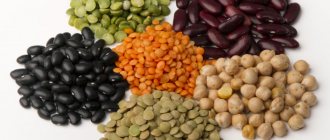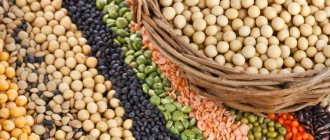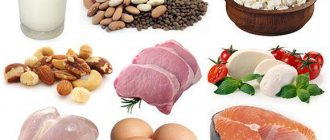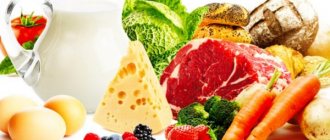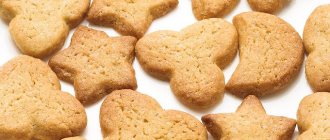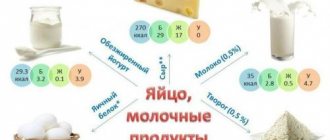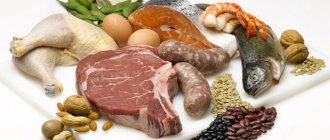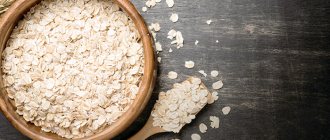A healthy lifestyle is triumphantly sweeping the planet. If earlier the so-called “heroin chic” was in favor, now preference is given to a healthy body, since only it, according to the Latin catchphrase, can contain a healthy spirit.
Sports provide the necessary form only by 30%, the rest comes from proper nutrition, which is based on the correct ratio of proteins, fats and carbohydrates. Practice shows that for most people it is quite difficult to get the first component to the daily norm, although this ingredient is contained in ordinary products that we use. For example, do you know how many grams of protein are in milk? No? We'll tell you below.
What is protein? Main functions and sources
Without protein, a full life is impossible - this is an axiom. Essentially, it is a building material that helps your body grow and maintain the cells that form muscles and bones. A person of average age and average weight needs approximately 130-160 grams of protein, depending on activity.
Animal products are the richest in protein. So, in descending order:
- lean meat, poultry, fish, cheese, low-fat cottage cheese - more than 15 grams of protein per 100 grams of product;
- fatty meat, semi-finished meat products, high-fat cottage cheese, eggs - 12-15 grams of protein per 100 grams of product;
- kefir, milk, sour cream - less than 10 grams of protein per 100 milliliters of product. But you need to understand that 100 grams of milk is very little, unlike 100 grams of meat. A regular glass has a volume of 250 ml. From here, finding out how many grams of protein are in a glass of milk is not so difficult - by using elementary mathematics we find out that there are about 9 grams of it, which, you see, is a lot with a total calorie content of 130 kcal.
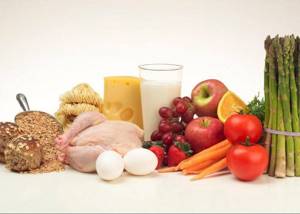
Report errors and inaccuracies
- Glasses 0.4 1 glass - how much?
- The calculations use the weight of only the edible part of the product.
Listed below are the nutrient standards that apply to the site.
What is useful about cottage cheese, what is contained in this product. How much protein does it contain – in fat and low-fat versions.
Cottage cheese is a healthy, tasty and satisfying product that is in great demand in bodybuilding. Its features are a large amount of protein (protein) and the presence of a number of other useful elements in the composition. It is obtained by fermenting milk and then removing whey from the composition.
Depending on the manufacturing method, it varies in fat content:
- Bold. In this case, the fat percentage is 18%.
- Bold – 8-9%.
- Low-fat – up to 3%.
Many athletes confidently claim that cottage cheese is a protein. And they are indeed right. The product (per 100 g) contains 15-18 g of casein protein , characterized by a rich amino acid composition and excellent digestibility.
At the same time, it takes an average of 2-3 hours to break down the protein. For this reason, it is recommended to take cottage cheese at night, in the morning or 2-3 hours before training. Below we discuss in detail how much protein is in cottage cheese, what beneficial substances are present in it, and what are the features of a homemade product.
Milk. Brief educational program
From the list of protein-rich foods, it becomes clear that most of them come from milk.
This food product accompanied society at every stage of its formation, and we do not touch upon the topic of breast milk, which nourished and supported a person from birth.
You cannot do without milk and fermented milk products if you care about your health and are aimed at maintaining muscle mass. Milk protein starts the process of protein synthesis in muscles after physical activity.
How much protein is in milk? We derive patterns
There is a direct relationship between the fat content of milk and the percentage of protein in it. On average it is 2.6-3.8%. It is not recommended to go to extremes, giving preference to milk with a fat content of 6% or higher, as well as striving for complete fat-free milk, 2.5% is enough.

| Milk, view | Fat,% per 100 ml | Protein,% per 100ml |
| Cow's milk | 3,9 | 3,6 |
| Goat milk | 4,3 | 3,4 |
| Sheep milk | 6,8 | 5,9 |
| Mare's milk | 1,1 | 2,0 |
| Donkey milk | 1,5 | 2,1 |
| Buffalo milk | 7,6 | 4,6 |
| Camel milk | 4,7 | 3,6 |
| Reindeer milk | 22,4 | 10,4 |
Vitamins
Of the fat-soluble vitamins, cow's milk contains A, beta-carotene, E and K. Of the water-soluble vitamins, there are vitamins C, B1, B2, B3 (PP), B4, B5, B6, B9 and B12.
>’> >’> >’> >’> >’> >’> >’> >’> >’> >’> >’> >’> >’> >’> >’> >’> >’>
| Vitamins, content | Share of daily value per 100 g | |
| Vitamin A | 28.0 mcg | 3,1% |
| Beta carotene | 7.0 mcg | 0,1% |
| Alpha carotene | 0.0 µg | 0,0% |
| Vitamin D | 0.0 µg | 0,0% |
| Vitamin D2 | n/a | 0,0% |
| Vitamin D3 | 0.0 µg | 0,0% |
| Vitamin E | 0.0 mg | 0,2% |
| Vitamin K | 0.2 mcg | 0,2% |
| Vitamin C | 0.2 mg | 0,2% |
| Vitamin B1 | 0.0 mg | 3,3% |
| Vitamin B2 | 0.2 mg | 14,2% |
| Vitamin B3 | 0.1 mg | 0,6% |
| Vitamin B4 | 16.4 mg | 3,3% |
| Vitamin B5 | 0.4 mg | 7,1% |
| Vitamin B6 | 0.0 mg | 2,9% |
| Vitamin B9 | 5.0 mcg | 1,3% |
| Vitamin B12 | 0.5 mcg | 22,1% |
How to add protein to food without losing taste? Powdered milk!
Information about skim milk powder gives us the opportunity to further enrich our food with protein. Let's look at this using the example of cottage cheese casserole. So, the ingredients:
- dry low-fat cottage cheese – 300 grams;
- eggs – 2 pcs.;
- skimmed milk powder – 25 grams;
- starch (preferably corn) – 20 grams;
- vanillin - a pinch;
- salt - a pinch;
- baking powder - 0.5 teaspoon;
- sugar (you can use a vegetable substitute if desired) - to taste.
We found out earlier how much protein is in milk, this casserole leaves it far behind, giving you 17 grams of protein per 100 grams.

To prepare it, preheat the oven to 180 C. Separate the whites from the yolks. Beat the whites with salt until stiff peaks form. In a separate bowl, mix all other ingredients until smooth. Carefully fold the egg whites into the curd mixture. Place the resulting dough in the pan and bake for half an hour.
Let the finished casserole cool for 10 minutes or it will fall apart. Serve with toppings and sauces to taste.
Homemade yogurt with milk powder
We already know how much protein is in milk per 100 grams – 3.6. There is about the same amount in yogurt with milk alone.
You can enrich it with protein by doing it yourself at home and adding the same skim milk powder in the process. Consider the recipe for a yogurt maker:
- low-fat milk – 1 liter;
- natural yogurt – 200 grams;
- skimmed milk powder – 4 tbsp. heaped spoons.
Mix yoghurt, milk powder and 200 ml regular milk until smooth. Stir the resulting starter into the remaining 800 ml of milk. Pour the resulting mixture into jars for the yogurt maker and proceed according to the instructions that come with the machine.
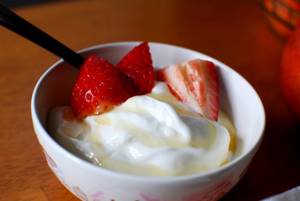
This recipe is different in that, in addition to enriching the yogurt with additional protein, we make it thicker.
This article makes it clear that, despite its composition not particularly rich in protein (see above for how much protein is in milk), this product serves as an excellent source material for cottage cheese, cheese, and so on, in which the protein content is several times higher.
Protein content in milk
To begin with, it should be noted that protein is the most important building material of cells in the human body. For example, if a person is actively involved in sports, then without protein products all his efforts will go down the drain. The muscles simply will not form.

Before dealing with the question of how much protein is in milk, you need to understand what kind of protein this product contains.
Milk contains two types of protein – casein and whey. The ratio of these proteins is different. It directly depends on what animal gave the milk (cow, goat, mare, etc.). If milk contains more casein, then it is called “casein”, and if it contains whey, then “albumin-globulin”.
So, how many grams of protein are in milk? It's hard to believe, but just one cup (200 ml) of this drink contains at least 8 g of pure protein. That is, a liter of milk contains 40 g of pure protein. That's a lot.
How to determine quality cottage cheese?
To get the maximum benefit from the product, it is important to consider a number of secrets that will help when choosing:
- Compound . The ideal option is when the composition contains only two ingredients - sourdough and cow's milk. But this rarely happens. Most often, enzymes, calcium chloride and other additives are added. Please note that the more auxiliary components, the lower the quality.
- GOST . Many people believe that TU and GOST are no different. This is wrong. If the product complies with GOST, then the manufacturer is responsible for ensuring that what is written on the packaging corresponds to reality.
- Price . Good cottage cheese should not cost less than a liter of milk. On average, the equivalent is as follows - 200 grams of cottage cheese = 0.5 liters of milk. In practice, the cost is even higher. If the price is too low, then there is a high risk of purchasing a fake.
- Best before date . A good product lasts no more than a week. If the shelf life is longer, then the composition contains a lot of preservatives that are unlikely to be beneficial to the body.
- Appearance . Excessive liquid or dryness indicates a violation of the technology. This option is not worth buying.
There is no need to check whether cottage cheese contains protein - this has already been proven. But it is necessary to establish the fact of the content of starch or vegetable fats. The following tests will help you:
- For vegetable fat content . To conduct the experiment, it is enough to leave the product for 24 hours at room temperature. If it has slightly soured and retained its color, then the quality is high. If a yellow coating appears and the smell changes, then this product is not natural.
- For starch content . The essence of the experiment is the contact of iodine with cottage cheese. If the mass has turned blue, then starch is present; if the color is still brown, then there is no starch.
In conclusion, it is worth highlighting a few recommendations in terms of preparing such a healthy dish. To obtain a better taste, cottage cheese can be mixed with the following products:
To dissolve it is worth adding:
- low fat sour cream;
- juice;
- kefir;
- yogurt.
That's all. Knowing how many grams of protein are in cottage cheese per 100 grams and how to prepare the product, it will not be difficult to formulate a diet, improve health and achieve your goals in sports.
Protein content of milk powder
Powdered milk is a concentrated product, which means the protein content per 100 g is higher than in regular milk. How much protein is in milk, or rather, in its dry form?
So, 100 g of dry product contains 25 g of protein. After an intense workout, it is recommended to eat 30 to 50 g of protein, which is about 100-200 g of milk powder.
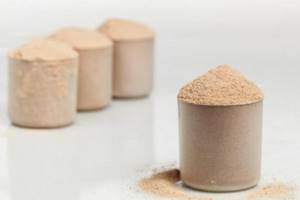
Why don't athletes like powdered milk? It's not about how much protein milk powder contains, but about fat and calories.
Powdered milk is very fatty, and when consuming, for example, 200 g of the product, the body immediately receives 50 g of fat and 1000 calories. Then many athletes switch to skim milk powder, thinking that this will solve the problem, but it does not.
Skim milk powder contains more slowly digestible protein, although the body needs fast digestible protein after exercise. Without this, muscle tone cannot be fully restored.
The issue of interchangeability
At the beginning of the 19th century, humanity first received such a food product as powdered milk. From the name itself it is clear what its specificity is - the product was successively normalized, pasteurized, thickened and, finally, dried to a powder state. This made it possible to store milk powder longer, while preserving most of the nutrients, including protein. How much protein is in milk powder? Depends on its fat content. The following types are distinguished:
| Types of milk | Fat,% per 100 grams | Protein,% per 100 grams |
| Whole milk powder | 26 | 25 |
| Skim milk powder | 1 | 36 |
As can be seen from the table above, there is already an inverse relationship between the amount of protein and the amount of fat per 100 grams of milk powder.
Initially, whole milk was used everywhere in the daily human diet, while skimmed milk was then used for animal feed and in confectionery production. Now the situation has changed, the second type of this product is ahead of the curve, as it gives people what they want: an abundance of protein (note how much protein is in skimmed milk powder - more than in chicken breast!) and modest fat levels.
Who should drink milk?
Of course, athletes primarily consume milk to build muscle mass, but they also receive a lot of calories along with milk. What about people who are watching their weight?
There is no need to completely give up this product, especially knowing how much protein is in milk. You just need to control its consumption. 1 cup of milk a day will be an excellent snack and will saturate the body with the necessary amount of protein.

Milk is also necessary for women during lactation and children. For nursing mothers, this drink will help restore the amount of milk produced by the glands, and the woman will be able to feed the baby on her own. Children need milk for normal development and growth of the body. In addition to casein and whey, this product contains a large amount of vitamins and, most importantly, calcium. By the way, calcium is perfectly absorbed in milk with a high fat content.
Amount of protein in different dairy products
100 g of cow's milk contains approximately 3.2 g of protein. Moreover, the fat content of this product does not affect the amount of protein in it. Approximately the same amount of this substance is contained in 100 g of cream and full-fat kefir. But the same amount of low-fat kefir contains a little more protein - about 4.2 g. Yogurt contains about 5 g of protein, and sugar-free condensed milk contains 7 grams.
As for cottage cheese, the amount of protein in this product directly depends on the fat content - a fatty product contains no more than 14 g of protein, medium-fat cottage cheese - about 17 g, low-fat - 18 g. In glazed cheese curds there is approximately 8 g of protein, in casseroles and cheesecakes - 17.7 grams. And in low-fat cheeses the amount of protein is approximately 30 g per 100 g of product.
Whey contains up to 1 g of protein, and whey concentrate contains up to 80 g of this substance. That is why the latter product, produced in powder form, is consumed in large quantities by athletes, especially bodybuilders.
Mineral composition
The ratio of minerals (macro- and microelements) contained in cow's milk is presented in the table using diagrams.
>’> >’> >’> >’> >’> >’> >’> >’> >’> >’> >’>
| Minerals, content | Share of daily value per 100 g | |
| Calcium | 120.0 mg | 12,0% |
| Iron | 0.0 mg | 0,2% |
| Magnesium | 11.0 mg | 2,8% |
| Phosphorus | 92.0 mg | 13,1% |
| Potassium | 140.0 mg | 3,0% |
| Sodium | 47.0 mg | 3,6% |
| Zinc | 0.5 mg | 4,4% |
| Copper | 0.0 mg | 0,7% |
| Manganese | 0.0 mg | 0,6% |
| Selenium | 2.5 mcg | 4,5% |
| Fluorine | 3.4 mcg | 0,1% |
The benefits of milk protein for the body
The protein contained in dairy products is absorbed by the body much better than meat. It contains a lot of essential amino acids that can only be obtained from the outside. Thanks to them, the body builds cells, produces hemoglobin and other complex and extremely important functions. Proteins are involved in the formation of compounds that provide the body's resistance to various infections, and help to better absorb other substances, such as fats or vitamins. In addition, animal proteins, including dairy proteins, provide a person with the energy he needs.
Cow's milk, curdled milk, kefir and cottage cheese are a valuable source of a type of protein such as casein. It ensures an even and gradual distribution of amino acids in the blood, which helps maintain a feeling of fullness for a long time. Such products are required for consumption by those who limit themselves in diet for a long time in order to lose weight.
Whey, especially whey concentrate, is rich in other types of beneficial proteins - albumin and globulin. Of all food proteins, these are the ones that are closest in amino acid composition to the proteins of human muscle tissue. In addition, they are a source of valuable essential amino acids. Albumin and globulin help lower the level of bad cholesterol in the blood and speed up the metabolism in the body, which helps break down fats faster. Whey proteins also have a calming effect because they lower levels of the stress hormone cortisol in the body. They are also found in other dairy products, but in much smaller quantities.
